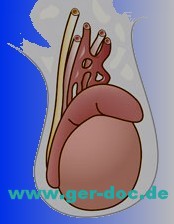
|
||
|
|
||
Category Archives: DiagnosticDiagnosis of testicular seminomaQuestion Answer: Diagnosis of Hodgkin’s disease by CT scan of the abdomenCT scan of the ABDOMINAL Scan Mode: spiral. Slice thickness: 1.0 mm Contrast enhancement – omnipak-350 100ml intravenously. The patient’s consent to the introduction of contrast agents received. Pathological reactions to the introduction was not recorded. The liver is usually not changed shape, dimensions: 17.4 cm right lobe, left 5.7 cm contours of her smooth, precise. The structure of homogeneous parenchyma density natively +43 H11. Intra-and extrahepatic bile ducts are not dilated. The gallbladder is usually not increased. In the lumen of radiopaque stones were found. Gate, splenic, inferior vena cava is not extended. The spleen is usually normal shape, size 14,8 x4, 8 cm, the contours of her smooth, clear, homogeneous structure, the density of the parenchyma natively +45 H11. The pancreas is a typical shape and size (26 mm head., The body is 24 mm, tail 22 mm. Its normal, the structure of the parenchyma moderately diffuse inhomogeneous density natively +30 BUT, clear outlines. Pancreatic duct with no signs of obstruction, not expanded. Parapancreatic Fiber is not changed. Determined conglomerates lymph nodes: in the gate spleen size up to 58×42 mm. (with gipodensivnymi sites in the structure), para-aortic to 37×30 mm. Free fluid in the abdominal cavity were not detected. Bone-destructive changes were found. Conclusion: CT signs of lymphoproliferative disease with enlarged lymph nodes and spleen at the gate paraaorgalnoy group (lymphoma). Hepatosplenomegaly. Diffuse changes in the liver, pancreas Мultiple MyelomaQuestion: Hello, Аnswer: We will be happy to help organize a diagnosis, consultation and treatment in Germany, your sister with our professors oncologists. MRI and MRA of the skullMR imaging and MR angiography of the skull nativeMRI and MRA of the skull after i.v. – contrast agent (gadolinium) Justifying end Indications: Layers and layer sequences: Findings: No abnormal signal in the white matter alterations. Assessment: |




















